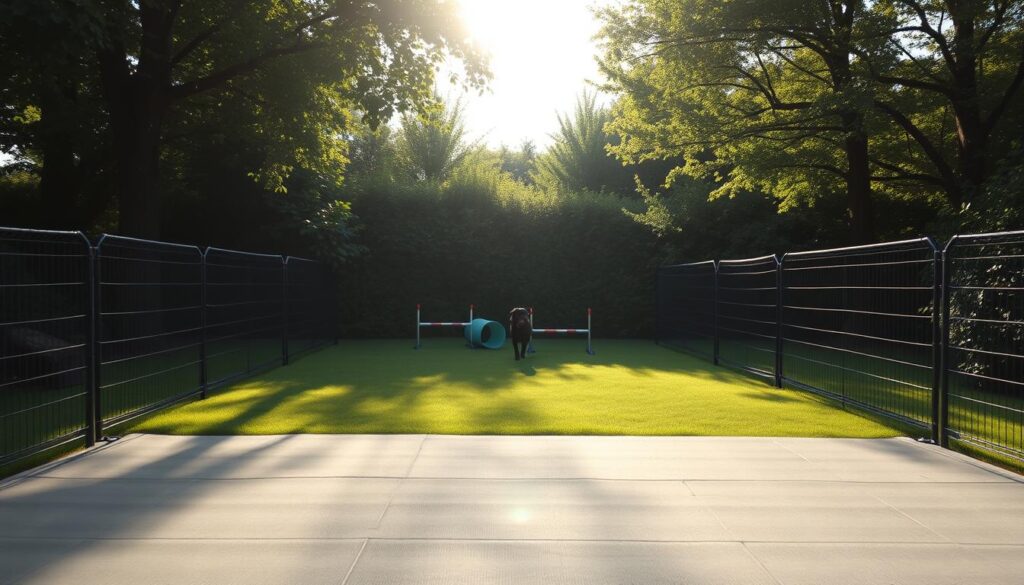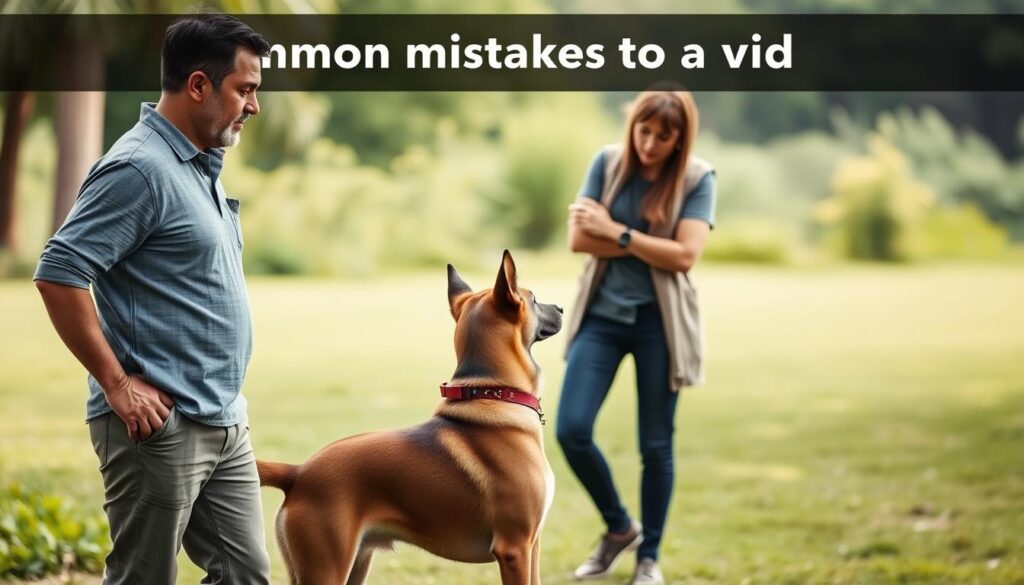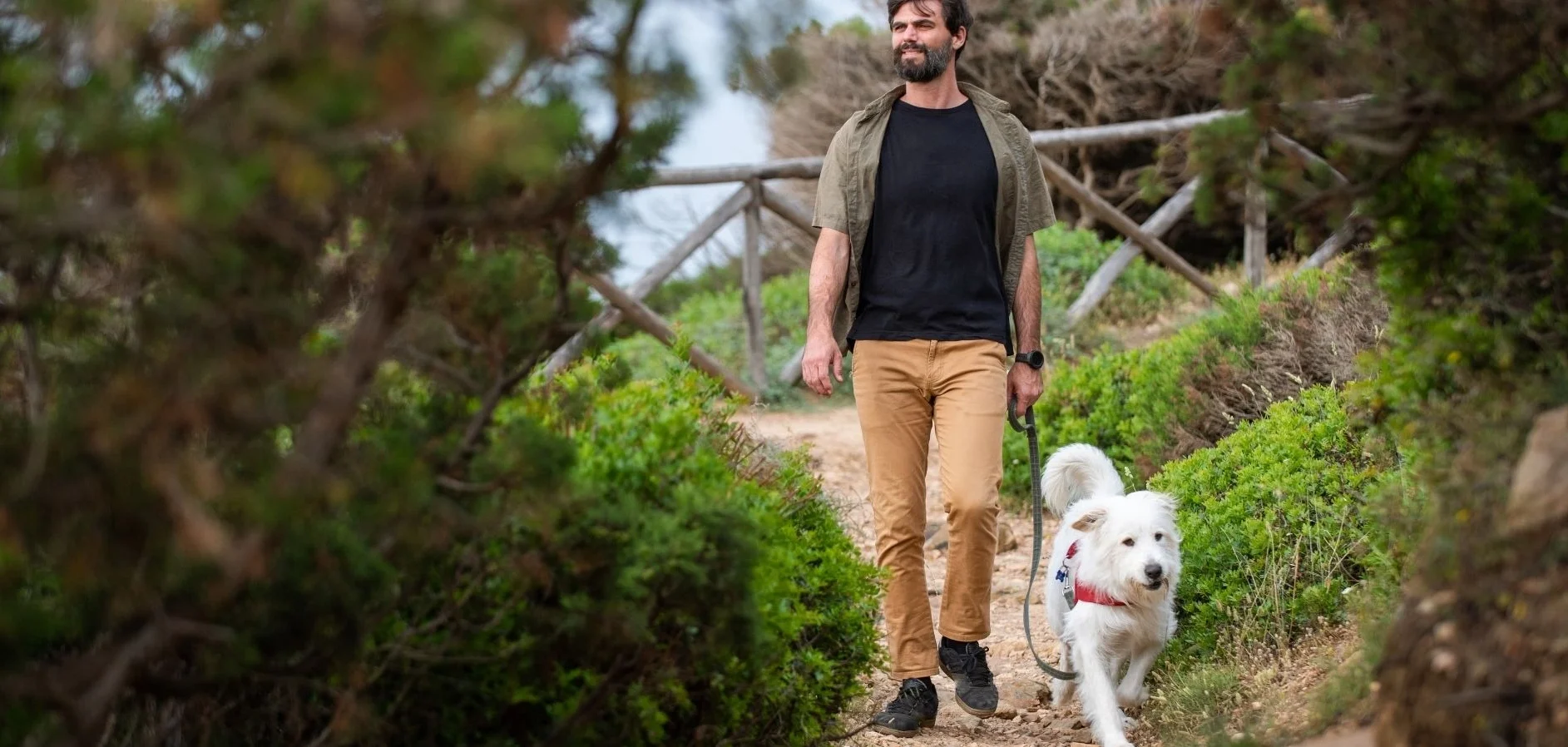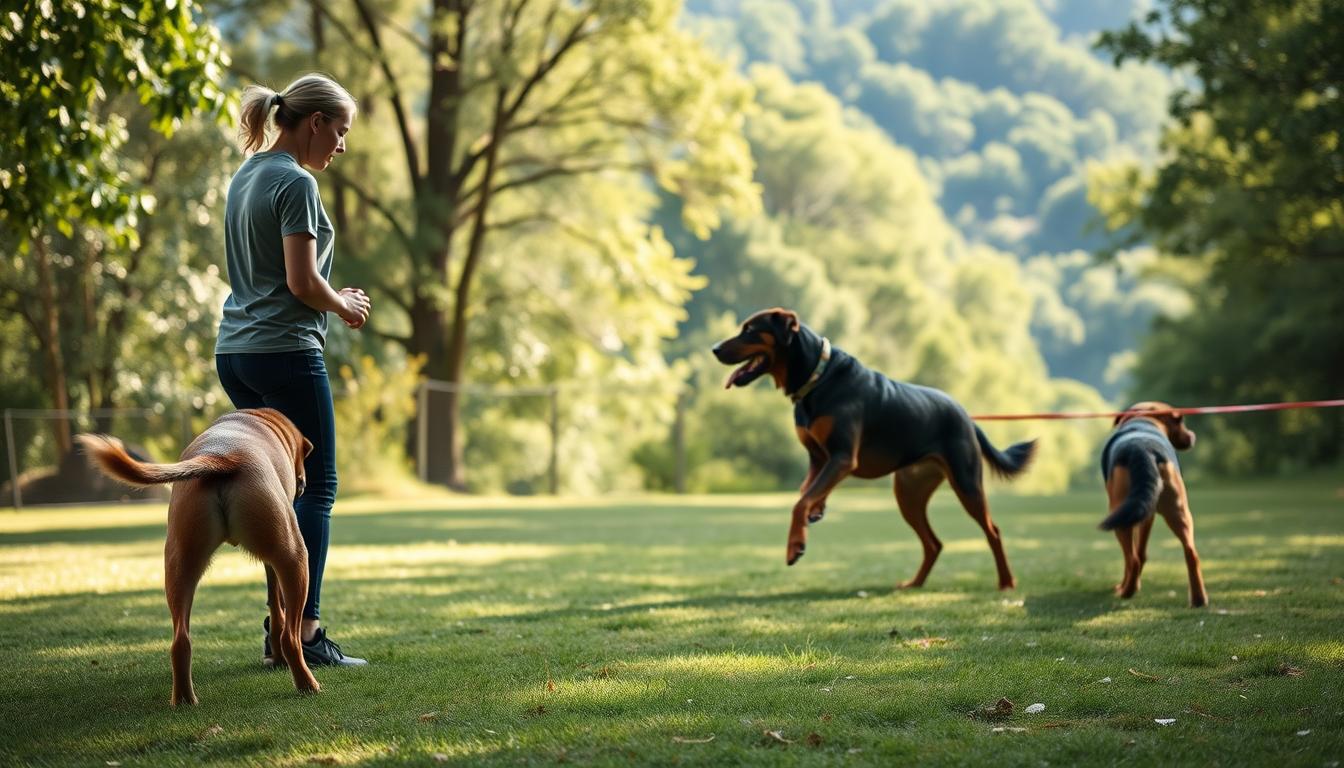Aggression Training for Dogs: Help Your Pup Find Peace
Table of Contents
Aggression training for dogs isn’t just about obedience—it’s about safety, trust, and building a strong relationship with your furry friend. In this article, we’ll explore proven techniques to manage and reduce aggressive behavior in dogs, no matter their age or background.
Dog aggression is not just a simple issue. It’s complex and needs patience, understanding, and smart action. This guide will help you understand and tackle aggression in dogs, whether it’s a new pet or a long-time friend with aggression problems.
Knowing why dogs get aggressive is key to a safer, happier home with your pet. With the right methods and expert advice, you can help your dog overcome bad behaviors. This will strengthen your bond and make your relationship more trusting.
Key Takeaways
- Dog aggression is a serious behavioral issue requiring professional approach
- Early recognition of aggressive triggers is crucial for effective training
- Positive reinforcement techniques are more successful than punishment
- Professional behaviorists can provide specialized intervention strategies
- Consistent training and patience are essential for behavioral modification
Understanding Different Types of Dog Aggression
Dog aggression is a complex issue that can show up in many ways. Knowing the different types of canine aggression is key to helping dogs. Each type needs a special way to train and manage.
Dogs get aggressive for many reasons. The first step is to understand why. The most common types include:
- Fear-Based Aggression
- Territorial Aggression
- Resource Guarding
Fear-Based Aggression
Fear-based aggression happens when a dog feels scared or very anxious. Your dog may react defensively when feeling cornered or overwhelmed. It’s a way for the dog to stay safe from threats.
“Fear is often the root of aggressive behavior in dogs” – Canine Behavior Experts
Territorial Aggression
Territorial aggression occurs when dogs feel their space or home is being invaded. Dogs with this type bark, growl, or show aggression when strangers or other animals come near.
Resource Guarding
Resource guarding happens when dogs get very protective of things like food, toys, or sleeping spots. During training, dogs learn that sharing doesn’t mean losing what’s important to them.
| Aggression Type | Primary Trigger | Common Signs |
|---|---|---|
| Fear-Based | Perceived Threats | Cowering, Growling, Backing Away |
| Territorial | Space Invasion | Barking, Lunging, Protective Stance |
| Resource Guarding | Valuable Items | Growling, Snapping, Blocking Access |
Managing canine aggression needs patience, understanding, and expert help. Each dog is different, so addressing aggression requires a custom plan. This plan must consider the specific type and reasons for the aggression.
Identifying Warning Signs and Triggers in Aggressive Dogs
It’s important to know the signs of dog aggression to train them well. Dogs show their feelings through body language and behavior. These signs can warn of aggression or stress.
Spotting these warning signs helps prevent aggression. Knowing how to read your dog’s body language is key. It helps manage their aggressive responses.
- Physical Warning Signs:
- Rigid body posture
- Raised fur along the back
- Showing the whites of the eyes
- Tail held stiffly or tucked under
- Behavioral Signals:
- Low growling
- Snapping without contact
- Excessive lip licking
- Frequent yawning
- Averting gaze
Aggression in dogs can be caused by fear, protecting territory, pain, or past trauma. Spotting these triggers early helps in training. You can then focus on the root cause of their aggression.
Early intervention is key to preventing aggressive behavior from becoming a persistent problem.
Professional trainers suggest watching your dog’s body language and how they react to their environment. Keeping a log of triggers helps tailor training to your dog’s needs.
The Role of Professional Dog Behaviorists in Aggression Training
Dog aggression is a tough issue that needs special help. A professional dog behaviorist is key for pet owners facing aggressive dogs. They use deep knowledge and smart plans to fix serious behavior problems.
When to Seek Professional Help
Think about getting a professional dog behaviorist if your dog shows:
- Repeated growling or snapping at people or other animals
- Uncontrolled lunging during walks
- Resource guarding that escalates quickly
- Sudden unpredictable aggressive outbursts
What to Expect from Behavioral Training
An aggressive dog rehab program includes a detailed check-up and custom plans. Your professional dog behaviorist will:
- Do a thorough behavioral check
- Find out what makes your dog aggressive
- Make a plan just for your dog
- Teach you and your dog together
Cost and Time Investment
Behavioral training takes time and money. Prices are from $100 to $300 per session. Most programs last 4-8 weeks. The cost shows the expert help needed for serious aggression.
Remember, early help from a pro can stop aggression from getting worse and bring peace back to your home.
Medical Causes Behind Dog Aggression
Caring for aggressive dogs needs a full approach, not just training. Sometimes, health issues can make dogs more aggressive. It’s key to know these health problems to help change their behavior.
Many medical issues can change how a dog acts and make them aggressive:
- Hormonal Imbalances: Problems like hypothyroidism can really change a dog’s mood and actions
- Chronic Pain: Dogs with hidden injuries or arthritis might become defensive and react aggressively
- Neurological disorders such as brain tumors or epilepsy
Vets say it’s important to check your dog’s health if their behavior suddenly changes. A full medical check can find health problems that might be causing the aggression.
Your vet can run tests to find medical reasons for aggression, like:
- Blood tests to check hormone levels
- Neurological checks
- Studies to see if there’s pain
By fixing medical issues, you can better care for aggressive dogs. This way, you can find the right ways to change their behavior.
Aggression Training for Dogs: Essential Techniques
Effective dog aggression training needs a smart plan. It’s about understanding and changing your dog’s behavior. The right methods can turn bad habits into good ones. Experts say patience, consistency, and kindness are key.
Good aggression training for dogs uses special ways to fix bad behavior. Dogs that act out need special help to feel safe and learn right ways to react.
Positive Reinforcement Methods
Positive reinforcement is a big part of good dog training. It rewards good actions, making dogs want to do them again. Important steps include:
- Using high-value treats during training sessions
- Providing immediate praise for calm behavior
- Creating consistent reward patterns
- Avoiding punishment-based techniques
Counter-Conditioning Strategies
Counter-conditioning changes how your dog feels about certain things. It makes them associate scary stuff with good feelings. This helps lower aggressive reactions.
- Identify specific aggression triggers
- Introduce controlled exposure
- Pair trigger encounters with pleasant experiences
- Gradually increase exposure intensity
Desensitization Exercises
Desensitization slowly gets your dog used to things that scare them. Slow, controlled interactions help build confidence and reduce reactive behaviors. Experts suggest structured exercises that respect your dog’s feelings.
The key to successful aggression training is understanding that every dog is unique and requires personalized attention.
Creating a Safe Training Environment

When you start aggressive dog training, making a safe space is key. It’s important for both you and your dog to succeed. You need to plan carefully and use the right strategies to avoid risks and help your dog learn.
Here are some important parts of a safe training area:
- Controlled training area with minimal distractions
- Proper safety equipment like muzzles or head halters
- Consistent boundaries and structured interactions
- Designated quiet space for your dog to decompress
Your training area needs to be well-managed to avoid triggers. Physical barriers and strategic positioning can prevent sudden problems. Use baby gates or separate rooms to control interactions during training.
Important safety steps for aggressive dogs include:
- Remove potential stress-inducing objects
- Ensure all family members understand training protocols
- Use protective gear when necessary
- Maintain calm and consistent energy during training
Creating a safe space is not just about the physical area. Your mood and leadership are also crucial. They help your dog feel safe and reduce aggression.
A structured, predictable environment is the foundation of successful aggressive dog training.
Socialization Strategies for Aggressive Dogs
Teaching an aggressive dog to behave well needs careful planning. It’s about helping them get along with others and people. This is done through structured exposure and building their confidence.
Understanding your dog’s behavior and comfort is key. Every dog is different. So, they need a socialization plan that fits their unique personality.
Controlled Introduction Methods
Here’s how to introduce your dog to new places or people:
- Start in quiet, neutral spaces
- Keep initial interactions short and positive
- Use high-value treats as rewards
- Monitor body language closely
Building Confidence Through Exposure
Slowly getting your dog used to new things helps. Systematic desensitization lets them get comfortable with scary things at their own pace.
| Exposure Level | Duration | Goal |
|---|---|---|
| Minimal Distance | 5-10 minutes | Initial comfort |
| Moderate Distance | 15-20 minutes | Increased tolerance |
| Close Interaction | 30+ minutes | Full social integration |
Managing Group Interactions
“Patience and consistency are key in transforming an aggressive dog into a well-socialized companion.” – Professional Dog Trainer
Dog parks can be challenging. Always check if your dog is ready. Be ready to step in if they show stress. Getting help from a pro can make a big difference.
Prevention Strategies for Dog Aggression
Preventing dog aggression starts with knowing your dog’s needs and creating a supportive space. It’s key to raise a well-adjusted dog. Early action can greatly lower the chance of bad behaviors.
Caring for aggressive dogs means being proactive in several areas:
- Early socialization during puppy development
- Consistent positive reinforcement training
- Addressing potential anxiety triggers
- Providing mental and physical stimulation
Puppies have critical times that shape their future. Exposure to different experiences builds confidence and lowers fear. Here are ways to lower aggression risks:
| Prevention Strategy | Key Benefits |
|---|---|
| Controlled socialization | Reduces fear and anxiety |
| Regular exercise | Decreases frustration and excess energy |
| Positive training techniques | Builds trust and communication |
Your effort to understand and use dog aggression prevention strategies can change your bond with your pet. By creating a caring environment and tackling behavioral issues early, your dog can grow into a confident and well-adjusted friend.
Common Mistakes in Aggressive Dog Training

Training an aggressive dog needs a careful and understanding approach. Many owners make mistakes that can make things worse. These errors can stop their dog’s rehabilitation program.
To change behavior, you need a smart and kind plan. It’s important to know and avoid common mistakes. This helps your dog learn good social skills.
Punishment-Based Approaches: A Counterproductive Strategy
Punishing aggressive behavior can make it worse. Harsh corrections can make dogs more fearful and anxious. They may also link negative experiences to certain triggers.
- Become more fearful and defensive
- Develop increased anxiety
- Learn to associate negative experiences with specific triggers
Inconsistent Training Methods
Being inconsistent can hurt your training efforts. Dogs need clear and predictable communication. Mixed signals or changing rules can confuse them.
- Confuse your dog
- Create uncertainty
- Diminish trust between you and your pet
Ignoring Early Warning Signs
Ignoring early aggression signs is a big mistake. Early intervention is key. Signs like growling or stiff body posture should not be ignored.
Professional dog trainers say that noticing and addressing early aggression can stop bigger problems.
Knowing these mistakes helps you create a better training environment. This supports your dog’s behavior change.
Managing Multi-Dog Households with Aggressive Dogs
Living with many dogs can be tough when aggression is a problem. To keep peace, you need a plan to manage aggression. This helps prevent fights between your dogs.
First, understand what makes aggression worse in homes with many dogs. Dogs may get upset over a few things:
- Resource competition
- Territorial instincts
- Unequal attention from owners
- Hierarchy disputes
To reduce fights, try these important steps:
- Give each dog its own space
- Feed them in separate areas
- Make sure everyone gets equal love and attention
- Use the same training methods for all
It’s key to watch how your dogs interact. Look out for signs that might mean trouble:
| Warning Sign | Potential Action |
|---|---|
| Stiff body posture | Immediate separation |
| Prolonged direct eye contact | Redirect attention |
| Raised hackles | Calm intervention |
Getting help from a pro can really help manage your dogs better. Look into hiring a certified dog behaviorist. They can create a plan just for your dogs.
Tools and Equipment for Safe Aggression Training
Choosing the right tools is key for safe and effective aggressive dog training. It’s important to pick equipment that helps manage tough behaviors. This ensures the safety and well-being of both the dog and the trainer.
Here are some essential safety tools for aggressive dog training:
- Muzzles to prevent potential biting
- Head halters for enhanced control
- Special leashes with additional grip features
- Protective training vests
Using the right equipment can greatly improve your training results. It also helps reduce risks during training sessions.
| Equipment Type | Purpose | Recommended Usage |
|---|---|---|
| Basket Muzzle | Prevent biting | Extended training sessions |
| Head Halter | Control movement | Redirecting aggressive behaviors |
| Long Training Lead | Safe distance management | Controlled socialization |
Professional trainers suggest investing in top-notch, breed-specific gear. This boosts training success and safety.
Keep in mind, no single tool can solve all aggressive dog training challenges. Success comes from consistent training, patience, and expert advice.
Conclusion
Training an aggressive dog needs dedication, understanding, and a smart plan. Your journey to help your dog is tough but doable with the right steps. By using the strategies from this guide, you can change your dog’s behavior and improve your bond.
The path to fixing an aggressive dog is slow but worth it. It involves building trust, understanding what makes them upset, and using consistent training. Getting help from a pro can be very helpful in dealing with dog aggression. Every dog is different, so what works for one might not work for another.
Being patient and using positive methods is key to success. Dogs do best when they feel confident, not stressed, and when they associate good things with training. With time and effort, many dogs can stop being aggressive and become loving pets.
The main goal of dog aggression training is to make a safe, loving home for you and your dog. Keep going, get help when you need it, and be kind and understanding. Your hard work can help your dog learn to get along better and become a happy family member.
There are no reviews yet. Be the first one to write one.


